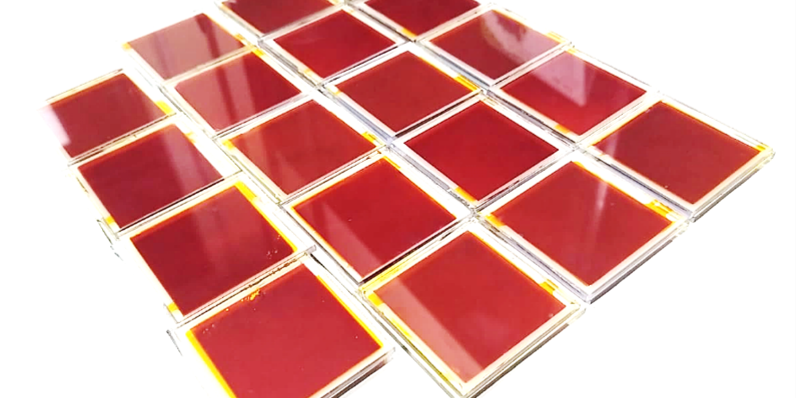A group of scientists led by India's National Institute for Interdisciplinary Science and Technology (CSIR-NIIST) claims to have boosted the stability and efficiency of dye-sensitized solar cells for indoor PV applications.
This type of solar cell, which is also known as a Grätzel solar cell, named after its inventor, EPFL Professor Michael Grätzel, is used for powering electronic devices such as wireless sensors or Internet-of-things, with indoor light.
“Our study introduces a significant advancement in dye-sensitized solar cells (DSCs) by utilizing starburst triphenylamine dye cocktails with a rigid, triple-bond conjugated π-backbone. This molecular design enhances light-harvesting capabilities in the visible region, providing an excellent overlap with indoor light spectra,” Suraj Soman, the research’s corresponding author, told pv magazine, noting that the design incorporated an asymmetric dual-species copper(II/I) electrolyte that had been introduced in earlier published research by the group.
The team developed the cell with a novel starburst triphenylamine sensitizer (RJ-C6) that was combined with XY1b dye and its own asymmetric dual-species copper(II/I) electrolyte. “The precise structural design of the dyes fosters synergistic effects, allowing for efficient molecular packing, enhanced dye loading, and improved visible light absorption,” Soman went on to say. “Furthermore, this configuration creates a robust barrier against back electron transfer and recombination.”
The most challenging aspect of the research was identifying the ideal combination of dyes for co-sensitization. “Small variations in molecular structures, such as altering alkyl chain lengths or incorporating triple bonds, can profoundly affect photovoltaic performance under low-intensity indoor light. Achieving optimal dye packing on the semiconductor (TiO₂) is critical,” said Soman.
The combinations of dyes, electrolytes, semiconductor porosity, and device architecture that perform well under indoor lighting differ significantly from those optimized for standard sunlight conditions. “Customizing all these parameters specifically for indoor applications was key to our success,” explained Soman.
The best performing devices had panchromatic absorption overlapping the entire fluorescent light spectra. According to the researchers, it achieved 35% under 100 lux, 37% under 1000 lux and a record efficiency of 40% under 4000 lux, which they said takes DSCs one step closer to being used as an “attractive candidate for indoor photovoltaic applications.”
The cell also achieved 10.40% efficiency under standard AM 1.5 G solar radiation, and a power conversion efficiency of 40% under indoor warm white compact fluorescent lamp (CFL) illumination.
As for stability, the academics reported that the RJ-C6 : XY1b co-sensitized devices demonstrated “promising stability” under accelerated indoor stability testing with no degradation even after 800 hours.
The cell measures 1.5 cm2 and has an active area of 0.32 cm2. The scientists pointed out that two of them combine in series with an active area of 0.68 cm2 could power a clock and a temperature sensor under 1000 lux CFL illumination.
“These advancements present a sustainable alternative to conventional primary batteries, potentially reducing the environmental impact of millions of discarded batteries that contribute to landfill waste,” stated Soman.
There are plans to take the technology from the lab and into practical indoor and outdoor PV applications. “We are working on developing battery-free, self-powered devices, and some innovative products are already undergoing field trials. Additionally, we are expanding our research into building-integrated photovoltaics (BIPVs) by developing colored, semi-transparent solar cells, aiming to integrate aesthetics and functionality for energy-efficient buildings,” said Soman.
The design and details of the research appear in “Enhanced indoor photovoltaic efficiency of 40% in dye-sensitized solar cells using cocktail starburst triphenylamine dyes and dual species copper electrolyte,” published in Journal of Materials Chemistry A. The team also includes scientists from the Academy of Scientifc and Innovative Research (AcSIR), and the National Institute of Technology Uttarakhand (NITUK).
This content is protected by copyright and may not be reused. If you want to cooperate with us and would like to reuse some of our content, please contact: editors@pv-magazine.com.



By submitting this form you agree to pv magazine using your data for the purposes of publishing your comment.
Your personal data will only be disclosed or otherwise transmitted to third parties for the purposes of spam filtering or if this is necessary for technical maintenance of the website. Any other transfer to third parties will not take place unless this is justified on the basis of applicable data protection regulations or if pv magazine is legally obliged to do so.
You may revoke this consent at any time with effect for the future, in which case your personal data will be deleted immediately. Otherwise, your data will be deleted if pv magazine has processed your request or the purpose of data storage is fulfilled.
Further information on data privacy can be found in our Data Protection Policy.